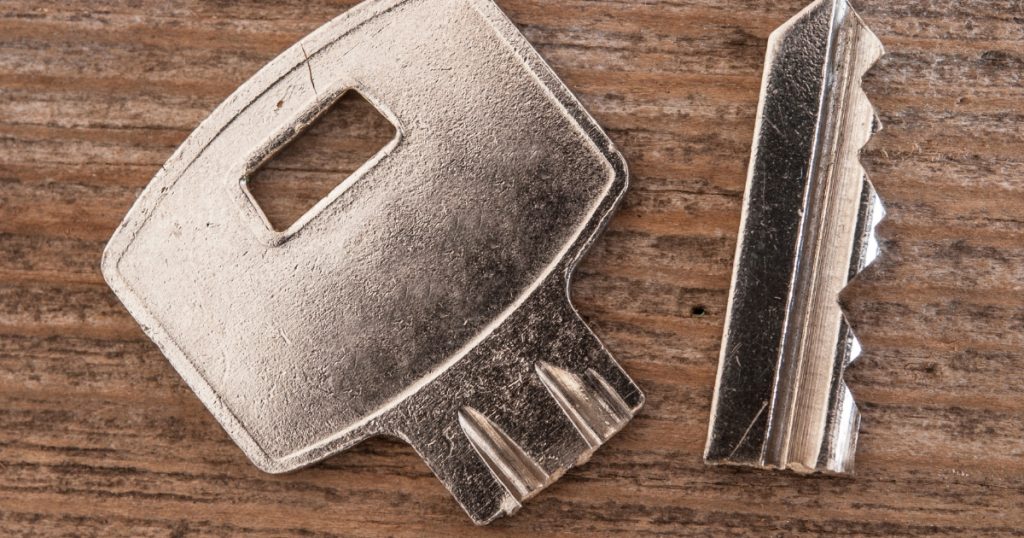The Common Issue of Snapped Keys in Locks
We’ve all been there—rushing to get inside, only to find that the key has snapped and a piece is stuck in the lock. It’s a frustrating and often daunting experience that can disrupt your day and leave you feeling helpless. Snapped keys are a common issue, especially in the United Kingdom where varying weather conditions can affect the durability of both keys and locks.
Who This Guide Is For
This comprehensive guide is designed to assist homeowners, tenants, and landlords in the UK who find themselves in this predicament. Whether you’re dealing with a Yale lock on your front door or a mortice lock on an internal door, this article aims to provide you with step-by-step instructions to safely and effectively remove a snapped key from a lock.
Understanding the Types of Locks Commonly Used in the UK
Before diving into the methods for removing a snapped key, it’s crucial to understand the types of locks you may encounter in the United Kingdom. Different locks require different approaches, and knowing what you’re dealing with can make the process smoother.
Yale Locks
Yale locks, also known as pin tumbler locks, are commonly found on residential front doors in the UK. They are generally easier to deal with when it comes to removing a broken key, thanks to their simpler internal mechanisms.
Mortice Locks
Mortice locks are often used for internal doors and sometimes for front doors as well. They are more complex than Yale locks and may require specialized tools or professional assistance for key removal.
Euro Cylinder Locks
Euro cylinder locks are frequently used in modern UPVC doors. These locks have a more complex mechanism and are often more challenging to tackle when a key has snapped inside them.
Safety Precautions
Before attempting to remove a snapped key from any lock, it’s essential to take certain safety precautions. This ensures that you not only protect yourself but also prevent further damage to the lock.
Necessary Tools
Gather all the tools you’ll need for the job, including:
- Tweezers
- Flat-head screwdriver
- Broken key extractor kit
- Lubricant (WD-40 or similar)
Safety Gear
It’s advisable to wear the following safety gear:
- Safety goggles to protect your eyes from flying metal shards
- Gloves to protect your hands from sharp edges
Initial Assessment
Before you start with any key removal method, it’s crucial to assess the situation carefully. This will help you choose the most appropriate and effective technique for your specific case.
Identifying the Depth of the Broken Key
First, take a close look at the lock to determine how far the broken key has gone in. The depth will influence which method you should use for extraction.
- Shallow Depth: If a significant portion of the key is visible, simpler methods like tweezers may suffice.
- Deep Depth: If the key is deeply embedded, you may need specialized tools or even professional assistance.
Assessing the Lock Condition
Check the condition of the lock itself. If it’s old or rusty, be extra cautious as applying too much force could cause further damage. In such cases, it might be advisable to consult a professional locksmith.
Methods to Remove a Snapped Key
Once you’ve assessed the situation and taken the necessary safety precautions, you can proceed to try one of the following methods to remove the broken key. Each method has its own set of steps and is suited for different scenarios.
The Tweezer Method
Suitable for: Shallow Depth Keys
- Prepare the Area: Ensure the area around the lock is well-lit.
- Grip the Key: Use a pair of tweezers to grip the visible part of the key.
- Gently Pull: Carefully pull the key out, avoiding any twisting motions that could push it further in.
The Tap and Pull Technique
Suitable for: Medium Depth Keys
- Insert a Flat-head Screwdriver: Place a flat-head screwdriver into the lock.
- Tap Gently: Tap the end of the screwdriver to help dislodge the key.
- Use Tweezers: Once the key has moved, use tweezers to pull it out.
Using a Broken Key Extractor
Suitable for: Deep Depth Keys
- Insert the Extractor: Slide the broken key extractor tool into the lock.
- Catch the Key: Turn the extractor so that it hooks onto the broken key.
- Pull Out: Carefully pull the extractor, bringing the broken key with it.
When to Call a Professional Locksmith
Despite your best efforts, there may be situations where removing a snapped key on your own proves to be too challenging or risky. In such cases, it’s advisable to seek professional assistance.
Signs That You Need Expert Help
- Multiple Failed Attempts: If you’ve tried multiple methods without success, it’s time to call a professional.
- Damaged Lock: If the lock shows signs of damage or wear, further attempts could worsen the situation.
- Lack of Proper Tools: Specialized tools are sometimes required for key removal, and not having them could complicate the process.
How to Choose a Certified UK Locksmith
- Check Credentials: Ensure the locksmith is certified by UK locksmith associations such as the Master Locksmiths Association (MLA).
- Read Reviews: Look for customer reviews and ratings to gauge the locksmith’s reputation.
- Get a Quote: Always ask for a quote before any work begins to avoid unexpected costs.
Preventive Measures
While dealing with a snapped key is a frustrating experience, there are steps you can take to minimize the likelihood of this happening again in the future.
Proper Key Maintenance
- Regular Inspection: Periodically check your keys for signs of wear or damage.
- Lubricate the Lock: Use a silicone-based lubricant to keep the lock mechanism smooth.
- Duplicate Keys: Always have a set of duplicate keys as a backup.
Signs of a Failing Lock
- Stiffness: Difficulty in turning the key is often a sign that the lock is wearing out.
- Rust and Corrosion: Visible signs of rust could indicate that the lock is nearing the end of its lifespan.
- Frequent Jamming: If the lock jams frequently, consider replacing it.
Legal Considerations in the UK
When dealing with a snapped key, it’s important to be aware of the legal aspects that may come into play, especially in the context of the United Kingdom.
Tenant and Landlord Responsibilities
- Tenant: Generally, if you’ve broken the key due to negligence or misuse, you may be responsible for the cost of repair or replacement.
- Landlord: If the lock or key fails due to wear and tear, the landlord is typically responsible for fixing it.
Insurance Implications
- Home Insurance: Some home insurance policies may cover the cost of a locksmith in the event of a snapped key. Check your policy details carefully.
- Liability: If you attempt to remove the key yourself and cause damage, this could affect any insurance claims.
Conclusion
Summary of Key Points
- Snapped keys are a common issue that many people face.
- Different types of locks require different approaches for key removal.
- Safety precautions and initial assessments are crucial steps before attempting any method.
- Professional help may be necessary in certain situations.
- Preventive measures can minimize the risk of future incidents.
Final Recommendations
If you find yourself dealing with a snapped key, don’t panic. Assess the situation carefully, take appropriate safety precautions, and attempt the methods outlined in this guide. If all else fails, don’t hesitate to seek professional assistance, especially from certified UK locksmiths.

